by Alison Hugill // Aug. 4, 2023
This article is part of our feature topic Wilderness.
For her recent commission at Mount Stuart—a 19th-century mansion on the Isle of Bute in Scotland—British artist Monster Chetwynd has engaged with a stalwart indigenous creature, the moth, in a manner in keeping with her celebratory and eccentric multi-dimensional practice. For the installation, Chetwynd has developed a series of elaborate sculptures and works on paper that dot Mount Stuart’s complex and historically-loaded interior. Having also created and filmed performances with local schoolchildren, she screens the footage inside of her impressive installation.
Meanwhile, on the grounds, she has re-purposed a pre-existing work, ‘Folding House’ (2011), which she’s transformed for the occasion into a “Moth Hub.” The Moth Hub acts as a site to engage with volunteers from Bute Museum & Natural History Society and local experts, who use the grounds for regular moth counts, contributing information to the National Moth Recording Scheme. The data from the scheme is used to conserve threatened moths and increase scientific understanding of moth declines and what they can tell us about the state of our planet. We spoke to Chetwynd about what drew her to the moths, and why she wants to highlight the role of local conservationists in this work.
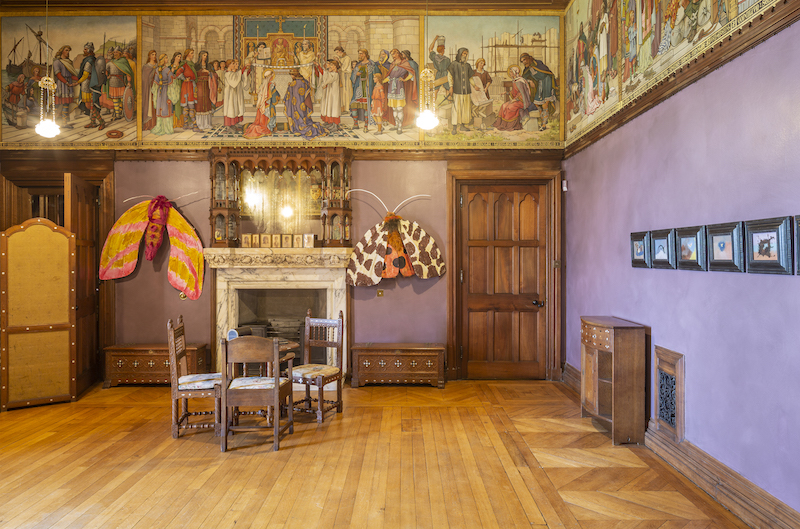
Monster Chetwynd: ‘Moths,’ 2023, installation view at Mount Stuart Trust, Isle of Bute // © Monster Chetwynd, courtesy Mount Stuart Trust, Isle of Bute, and Sadie Coles HQ, London, photo by Keith Hunter
Alison Hugill: Can you tell us about how your multi-layered new commission ‘Moths’ at Mount Stuart came about?
Monster Chetwynd: I was invited to go to Mount Stuart initially on a site visit. I found it very beautiful and very happy, as a trip, but when I was inside the house I was completely overwhelmed by how decorated it was and how many layers of ornament there were. Every inch of every room is covered in some sort of skilled work from different periods of history. When you’re in the house, it’s hard to work it all out. There are a lot of earlier works—for example, an original text by Shakespeare or a Velasquez painting—but the house itself is sort of Edwardian looking.
I was initially very impressed by it but didn’t know how to contribute. On my second site visit, I spotted something: the presence of a quite humble seeming conservationist, who was on the grounds collecting and monitoring moths. I was intrigued to know more.
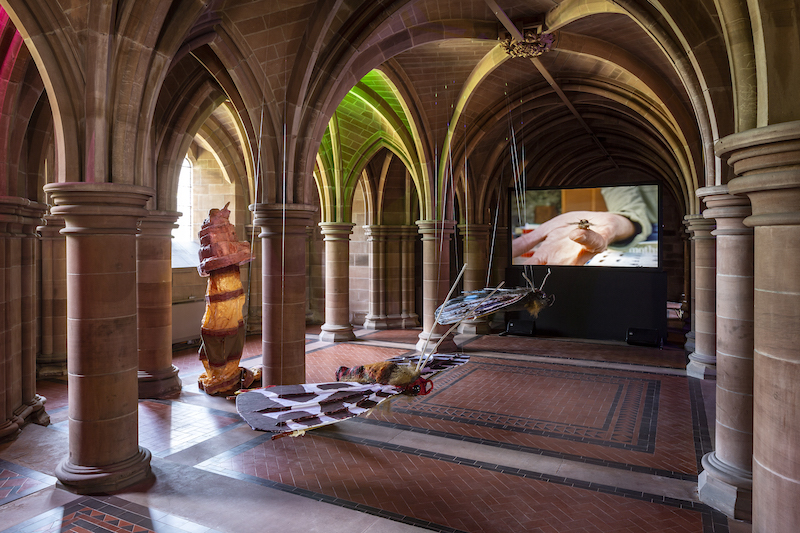
Monster Chetwynd: ‘Moths,’ 2023, installation view at Mount Stuart Trust, Isle of Bute // © Monster Chetwynd, courtesy Mount Stuart Trust, Isle of Bute, and Sadie Coles HQ, London, photo by Keith Hunter
AH: What spoke to you about the moths?
MC: There were a couple of things that made me feel inclined to them: one was that I have studied bats since around 2000. I’ve been painting an ongoing series for over 10 years called ‘Bat Opera.’ I very simply thought that moths are another nocturnal creature, not very well regarded in culture. In another little door in my head, I remembered reading ‘Austerlitz,’ which I found very moving. Part of the joyful moment in that book is when he is going home with his friend from boarding school and he’s introduced to some moths at night. There’s a really beautiful and poetic description [of the moths] as if they are gentlemen going to the opera wearing cloaks. It really held me, because there’s so little joy in the book. And when you open the lid on moths, there are thousands of species. It’s a lot like bats. They have so many different spellbinding ways to impress you.
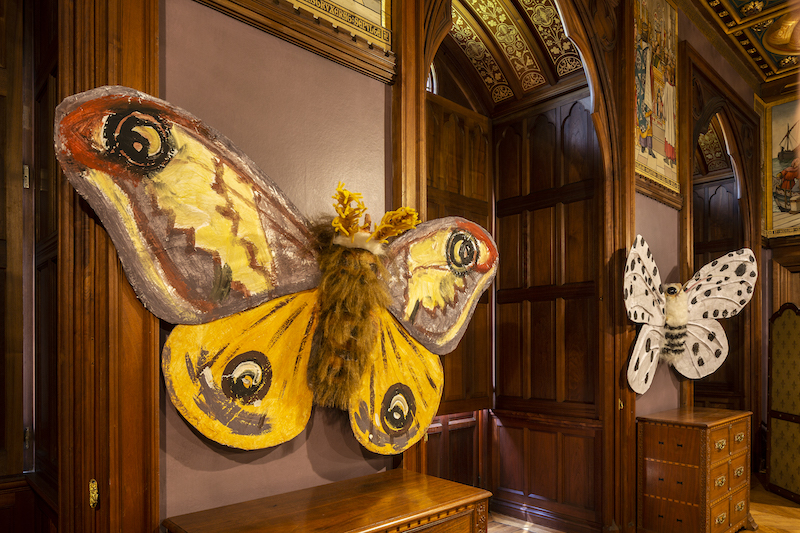
Monster Chetwynd: ‘Moths,’ 2023, installation view at Mount Stuart Trust, Isle of Bute // © Monster Chetwynd, courtesy Mount Stuart Trust, Isle of Bute, and Sadie Coles HQ, London, photo by Keith Hunter
AH: What role did the nature on the Isle of Bute play in your commission?
MC: There were two guys I met on my second site visit, Ron and Bill. They are wonderful and very charming. They’re a slightly older, retired duo and they have a very gentle, comic relationship. They had set different moth traps up around the grounds of Mount Stuart, but they also monitor the whole of the island. In the night, the moths go into this very gentle trap—a box with a light in it and egg cartons. They burrow into it and sort of sleep, and in the morning you can pull out an egg box and find the moths. They’re very sleepy, but you can handle them. Ron and Bill have very good books that identify them by their different markings.
Their work is really just to count the moths, making clear what they find. It’s not interpretive, they don’t make speculative theories about what’s happening to the world. They are very calmly doing a count and then they give that information to organizations and people who really value the data.
I researched some of the moths that were, in my mind, very exotic—like one called the pink elephant hawk moth that has a triangle shape with pink and green colour. The emperor moth and the garden tiger moth are also both stunning. The latter has the ability to outwit bats. It has its own radar sound that interferes with the bats’ target on it. It’s like an arms race of nature. I mentioned this research to Ron and Bill and they didn’t know about it. So it was very clear that they were just counting and identifying them. Their conservation effort is more to do with rigorous statistics. They are watching and observing.
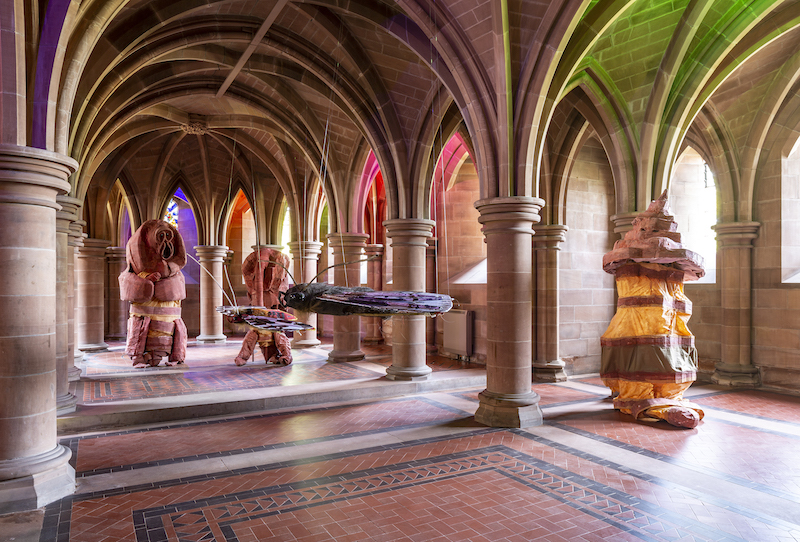
Monster Chetwynd: ‘Moths,’ 2023, installation view at Mount Stuart Trust, Isle of Bute // © Monster Chetwynd, courtesy Mount Stuart Trust, Isle of Bute, and Sadie Coles HQ, London, photo by Keith Hunter
AH: This is potentially interesting as a kind of “rewilding” technique: letting go of this need to control nature and rather simply observing what it can tell us.
MC: It makes me think of the Werner Herzog quote [from Grizzly Man] where he looks in the camera and says: “nature is chaos, violence and murder.” There’s no romanticizing on my part of nature being picturesque or a model to follow. But I do have a genuine connection with and love for conservationists who take something that is generally disregarded and communicate it. For me, if I’m going to go to Bute and I can choose to make any art project, of course I’m going to make a gentle project where children get to research their local indigenous moths, which are the most stunning colours and the most ravishing shapes.
AH: Yes, you involved local schoolchildren in the production, right? Can you tell us about the participatory element?
MC: It’s the kind of thing that some artists would totally avoid, but I am really ok with educational programs. When I first started out as an artist I was quite skeptical about people from higher up thinking if they put a policy in place it would make the world better. But having witnessed efforts to get people into museums who normally wouldn’t be there, I now really believe in it. If they go when they are children, they’ll already have the confidence to feel comfortable going when they are teenagers and grown ups.
We had three different local schools involved and I worked with a filmmaker, Margaret Salmon. She’s amazing with 35mm, 16mm—she’s a truly amazing celluloid filmmaker. Rather than make a live performance, the ambition was to make a film with the schoolchildren. I made loads of costumes and props. It was really good, but the kids burnt out fast: they gave unbelievable amounts of energy and then they couldn’t cope anymore. So it was a learning process throughout the three groups and it got better with time. That features as a film within the installation.
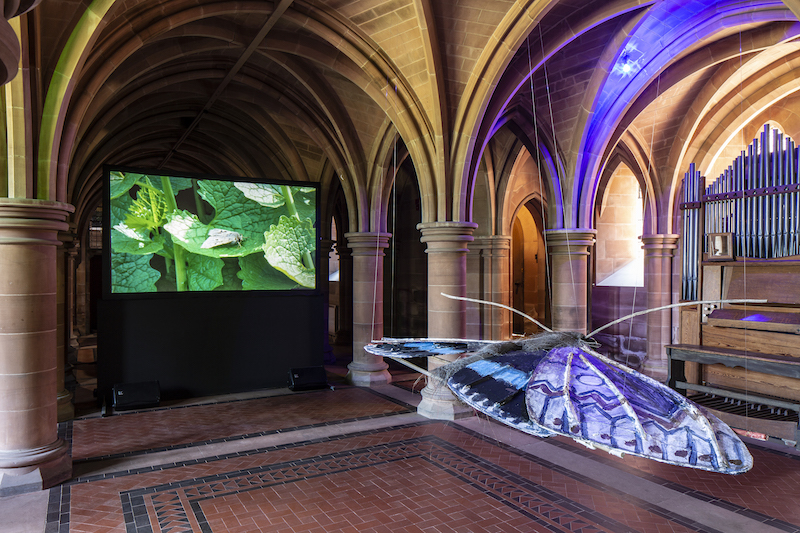
Monster Chetwynd: ‘Moths,’ 2023, installation view at Mount Stuart Trust, Isle of Bute // © Monster Chetwynd, courtesy Mount Stuart Trust, Isle of Bute, and Sadie Coles HQ, London, photo by Keith Hunter
AH: And how did you repurpose your older work, the ‘Folding House,’ for this commission?
MC: The ‘Folding House’ is basically recycled single-glazed windows, which were being thrown away because the UK government was now allowing double-glazing on windows, which would be more ecologically sound because you use less heating. I gathered up these materials with metal frames and made a small house that could fold up and fold down. I had previously used it for a performance for the British Art Show 7 that had to do with researching alternative energy. I was really interested in the topic because it felt like a trigger subject in 2011. It was a very stressful subject to have a conversation about at that time. I realized if I made an elaborate performance with a mechanical ballet and different elements, then maybe I could have a conversation about it. And that really worked. I suggested to the Mount Stuart team that I could use the ‘Folding House’ for a similar backdrop or “hub” for the moth research and conversations around it.
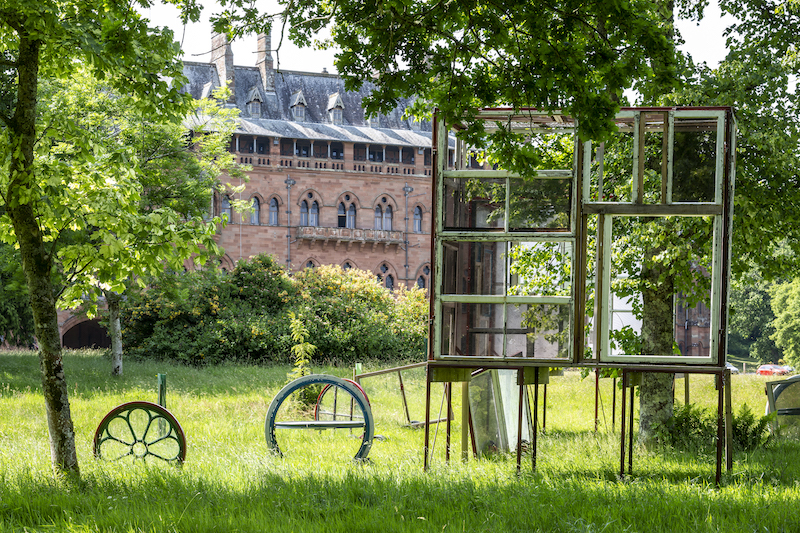
Monster Chetwynd: ‘Moths,’ 2023, installation view at Mount Stuart Trust, Isle of Bute // © Monster Chetwynd, courtesy Mount Stuart Trust, Isle of Bute, and Sadie Coles HQ, London, photo by Keith Hunter
AH: This commission is positioned as provoking “a serious consideration of the ongoing climate emergency.” You mentioned the difficulty of talking about environmental issues in 2011. How do you see your work fitting into the wider conversation now?
MC: I’m a little bit scared of being overtly political. I feel it leads to criticism. For example, the costumes are all made out of recycled materials, like cardboard, but I’m the first to admit that I also used a glue gun. I flew to Scotland. There’s always going to be something that can be picked apart. I don’t have all the answers, but I know that I am not worn out trying yet. I don’t have activist burn-out. I’m really interested to see how certain insights can be disseminated and to find out how to disarm an audience with my work, in order to have these conversations.
Exhibition Info
Mount Stuart
Monster Chetwynd: ‘Moths’
Exhibition: June 10–Aug. 20, 2023
Admission: £ 16.50 (reduced £ 14)
mountstuart.com
Rothesay, Isle of Bute PA20 9LR, UK, click here for map






















